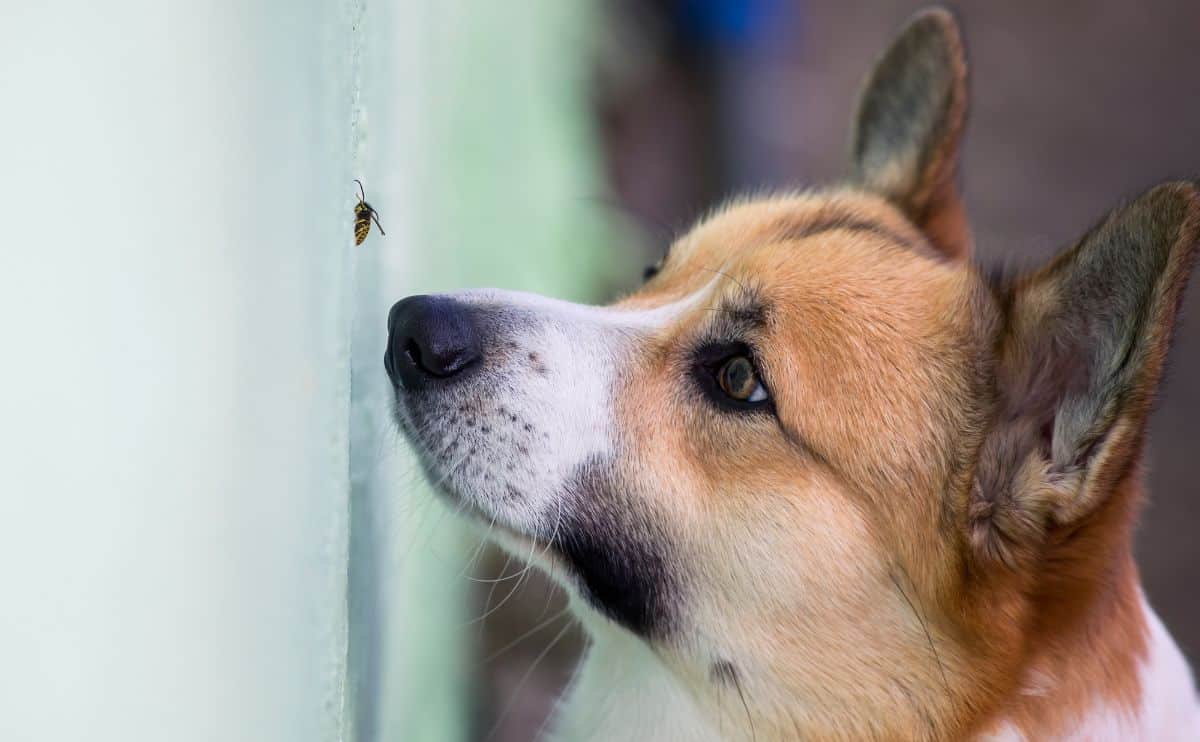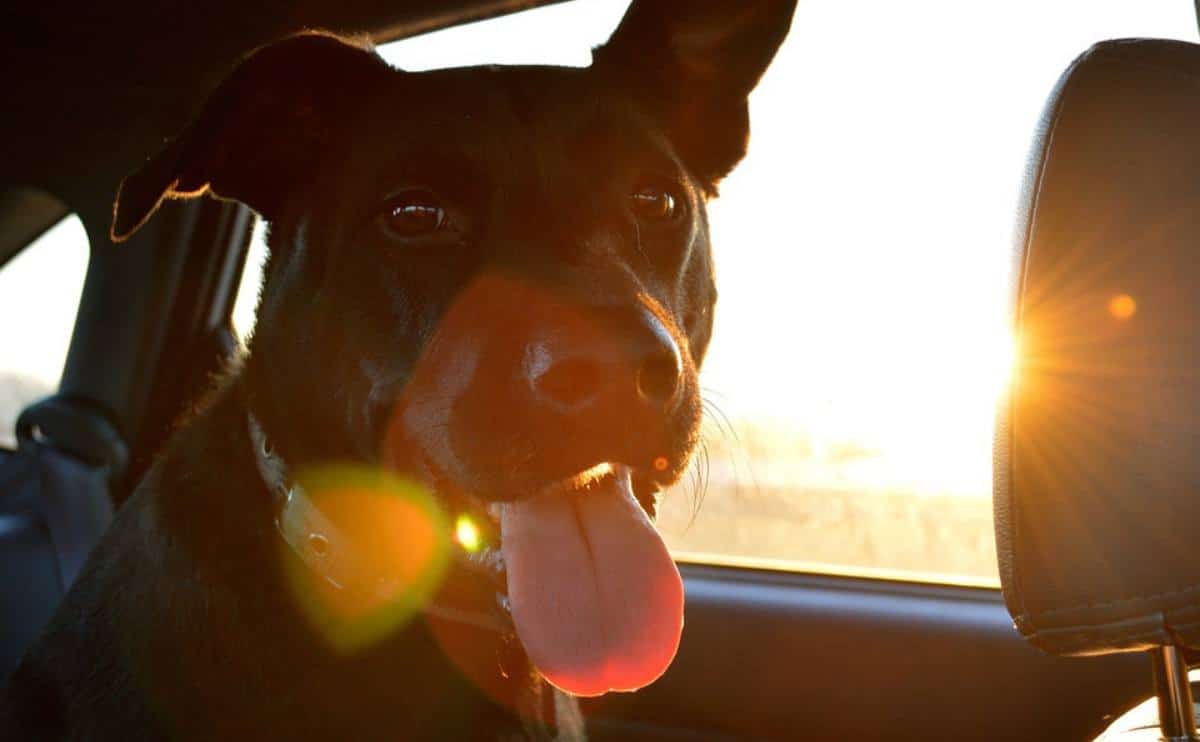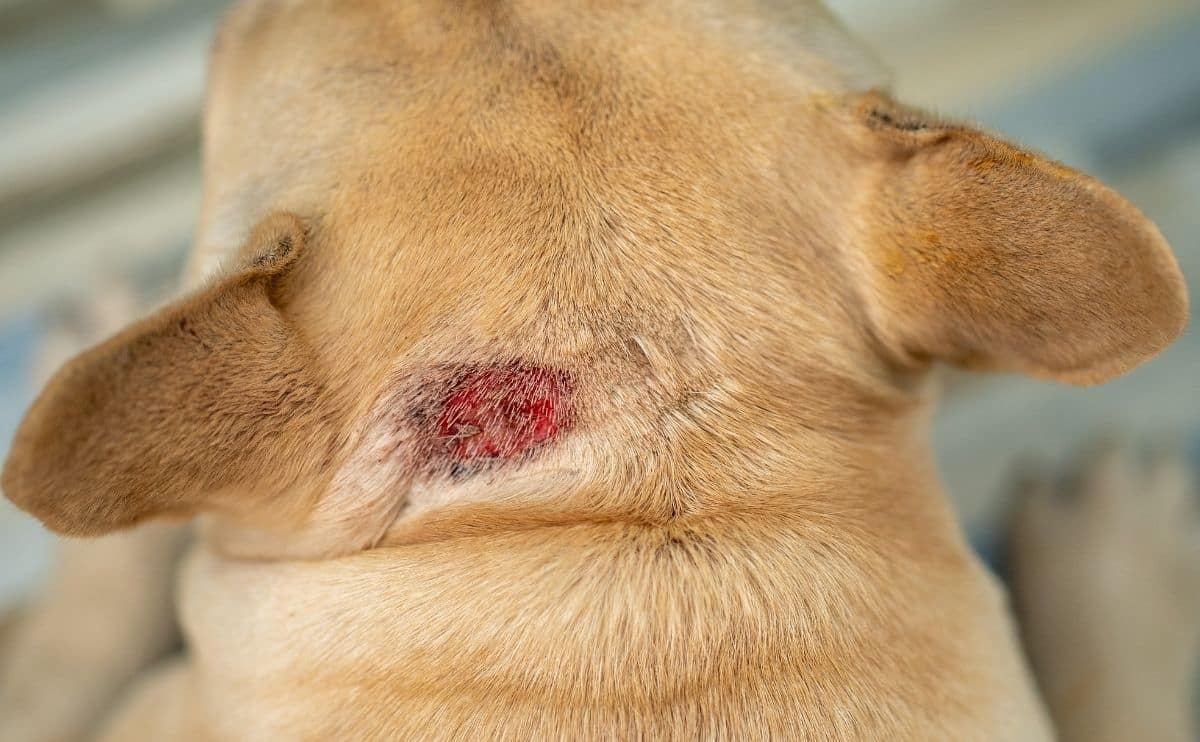Dog Got Stung? What Every Owner Must Do In The First 60 Minutes
When you purchase through links on our site, we may earn a commission. Here’s how it works.
Was your dog stung by a bee? Summer blooms spell danger for curious dogs. And a single sting can turn a playful pup into a swollen, drooling mess within minutes.
Table of Contents
If your dog suddenly yelps, paws at a swollen muzzle, or starts drooling after buzzing around a flower patch, knowing precisely what to do in the next 60 minutes could make all the difference.
The Puffy Face Panic: What A Dog Bee Sting Really Looks Like
You might not even see the sting happen, but you’ll know something’s off fast. One second, your dog is happily sniffing around. Next, they are pawing at their face, shaking their head, or limping like they stepped on something sharp.

Bee stings on dogs usually occur on the nose, mouth, paws, or inside the mouth if the dog tries to bite the insect.
Dogs often do not learn from one mistake. They will try to eat a bee repeatedly. That is why knowing what a sting looks like is essential.
Symptoms of a sting include:
- Sudden swelling, especially around the snout or paws
- Redness or warmth around a single spot
- Whining, licking, or favoring a leg
- Sudden limp or reluctance to move
Some dogs get stung and just sneeze. Others look like they have been socked in the face by a cartoon fist.
Quick Takeaway
- Bee stings often swell fast, but are not always emergencies
- Stay calm because your reaction affects theirs
- Reactions can peak within 30 to 60 minutes
Bug Bite vs Bee Sting: Can You Tell The Difference?
Not all bites and stings are created equal.
Bee stings cause immediate swelling and pain, often with a visible stinger. Mosquito bites itch like crazy but are usually harmless. Spider bites? That is a whole other conversation.
Telltale signs it was a bee sting:
- Swelling appears within minutes
- Stinger may be visible on the skin
- Your dog yelped or snapped at the air
Signs it might be something else:
- Delayed swelling or multiple red bumps
- No stinger or point of contact
- Your dog seems itchy but otherwise normal
If in doubt, treat it as a sting and observe closely.
How To Yank Out A Bee Stinger Without Making Things Worse
If you can spot the stinger, you have already won half the battle. Only bees leave stingers behind. Wasps and hornets do not.
Most dog owners make one big mistake: they grab the stinger with tweezers. That squeezes the venom sac and pushes more venom into the wound.
What to do instead:
- Use a credit card or a dull plastic edge
- Place it flat against the skin and gently scrape across the sting site
- Rinse the area with cool water and mild soap
- Dry with a clean cloth
- Apply a wrapped ice pack for 10 minutes
Keeping your dog still and calm will help minimize the spread of venom. No running or jumping.
If you are out on a hike, a plastic hotel room key or laminated tag can work in a pinch.
When A Lump Is Fine & When It Is Time To Freak Out
Not all reactions are the same. Some dogs shake it off and keep moving. Others can develop a full-body allergic response.
Mild Reaction Signs
- Small raised bump or localized swelling
- Minor itching or licking
- Slight favoring of a leg
- Returning to normal behavior after 30 to 60 minutes
Moderate To Severe Reactions
- Swelling spreading rapidly, especially near the mouth or eyes
- Hives or blotchy red patches on the belly
- Vomiting, diarrhea
- Difficulty breathing or wheezing
- Pale gums, lethargy, collapse
Reactions can escalate even after mild symptoms. Continuously monitor for at least two hours after the sting.
If your dog is struggling to breathe or appears disoriented, contact the emergency veterinarian. Minutes matter.
At-Home Relief Kit
Looking for quick remedies for bug bites and bee stings on dogs? Here’s how to treat a bee sting or bug bite on a dog that’s having a mild reaction:
- Wrapped ice pack or frozen veggies
- Calm environment, no rough play
- Monitor for vomiting, swelling, or breathing issues
Keep them close and comfortable. If swelling worsens or does not improve within 24 hours, contact your veterinarian. Better to act early than miss a life-threatening change.
Take a photo every 10 minutes to track swelling.
The Four Dollar Fix That Can Stop A Swollen Snout
If it’s a mild reaction, you may be able to treat it at home. This is where Benadryl helps.
Benadryl, or diphenhydramine, is a safe antihistamine for many dogs, but only with your vet’s approval.

Common dosage: 1 milligram per pound of body weight. A 25-pound dog would receive one 25-milligram tablet. Use plain Benadryl only. No decongestants or combination medications.
More Insect Sting Home Treatments
- Soothe a bee sting with a thick paste of baking soda and water due to the acidic nature of bee venom. But, if your dog is stung by a wasp or hornet, you should neutralize it with vinegar or lemon juice.
- If there are multiple stings, you can relieve your dog’s discomfort with an oatmeal bath.
Our Personal Hornet Sting Experience
Our dog Lily was stung on her leg by a hornet while on a walk. We gave her Benadryl as soon as we got home and monitored her symptoms closely for any changes. We also iced the area for 10 minutes every hour during waking hours.
While she was still limping, this treatment combo helped to reduce some of the swelling and discomfort. Luckily, she was feeling much better after about 30 hours.
– Michelle Schenker, Rescue Dog Parent, Canine Journal Co-Founder & Licensed Insurance Professional
What Not To Do When Your Dog Gets Stung
Panic is the worst first step. When your dog is stung by a bee, staying calm helps them remain calm and allows you to think clearly.
Unfortunately, some well-meaning pet owners make mistakes that can worsen the sting or delay recovery.
Avoid these common missteps:
- Don’t use tweezers to remove a stinger. This can squeeze more venom into the wound. Use a flat edge, such as a credit card, to scrape it out.
- Don’t apply essential oils or creams not designed for dogs. Some oils can be toxic or worsen irritation.
- Don’t skip monitoring. Just because the swelling looks minor doesn’t mean it won’t escalate. Watch your dog closely for two hours after a sting.
Also, don’t give any over-the-counter human medications without consulting your veterinarian.
Some pain relievers, like ibuprofen or aspirin, are dangerous for dogs. Stick to approved treatments and first-aid strategies, and call your vet if you’re unsure.
If your dog is highly anxious or licking the sting site obsessively, try distracting them with a treat puzzle or gentle massage. Minimizing stress reduces inflammation and keeps their heart rate down while you observe.
The Silent Killer: One Sting That Could Shut Down Their Airway
This is the terrifying part: anaphylaxis. It is rare, but when it strikes, it can be fast and fatal.
Small dogs and puppies are especially vulnerable due to their size. Swelling near the throat or mouth can quickly block the airways.
Signs Of Anaphylaxis
- Sudden vomiting or diarrhea
- Collapse or tremors
- Blue or gray gums
- Extreme swelling of the muzzle or neck
- Breathing difficulty, wheezing, choking
You cannot treat this at home. Grab your keys and go to the vet immediately.
How Vets Handle Bee Stings: Behind the Scenes
When you walk into the emergency clinic, the clock starts ticking. The vet will assess swelling, breathing, and heart rate.
In severe cases, they administer epinephrine to stop anaphylaxis. They may also give antihistamines, steroids, and IV fluids.
Your dog may be monitored for several hours, especially if there is a history of allergic reactions.

Expect blood work and a follow-up plan. In some cases, dogs are prescribed an EPI-Pen to keep at home if they are high-risk. Venom immunotherapy (VIT) may also be recommended to reduce the risk of life-threatening reactions in the future.
Sting-Proof Your Walks With Easy Prevention Tricks
Some dogs are sting magnets. If your pup chases bees, chews on flowers, or sticks their nose where it does not belong, you need a prevention plan. A few small changes in your daily routine can save you from scary vet visits and sky-high bills.

Start with awareness. Know where stings are most likely to happen. Then add simple tools to minimize risk.
Sting Prevention Tips
- Stick to wide paths and avoid thick grass
- Keep your lawn short to discourage bees
- Check your yard regularly for hives or nests
- Use dog-safe repellents like lemon eucalyptus spray
- Put protective booties on curious pups
- Teach a strong “leave it” command
High-Risk Dogs
- Puppies who chew everything
- Small breeds with narrower airways
- Dogs with previous allergic reactions
Consistency and awareness go a long way in prevention.
Frequently Asked Questions
Was your dog stung by a bee? Here are some frequently asked questions regarding bee stings. Don’t see yours? Ask us in the comments!
How Long Does A Bee Sting Last On A Dog?
If your dog has been stung by a bee, mild symptoms usually improve within a few hours. Swelling may go down in 24 to 48 hours, although the sting site could remain a little tender. During this time, monitor your dog for any unusual behaviors like scratching or licking the area.
In more moderate cases, especially with larger swelling or repeated stings, it might take several days for symptoms to fully disappear. Watch for signs of secondary infection like increased redness, pus, or prolonged discomfort. If healing stalls or worsens, consult your vet.
Try to keep your dog from excessively scratching or licking the area to prevent infection. An Elizabethan collar (aka a cone) can help with preventing your dog from bothering the sting site.
My Dog Got Stung By A Bee In Mouth: What Should I Do?
A dog stung by a bee in the mouth or throat is in a higher-risk situation. Stings inside the mouth can cause severe facial or neck swelling, which may block your dog’s airway and compromise their ability to breathe. Small breeds and short-nosed dogs are especially vulnerable to respiratory complications.
Even if your dog seems fine initially, look out for signs like gagging, drooling, difficulty swallowing, or swelling near the lips and jaw. These may signal a growing emergency. Contact your vet immediately—do not wait for symptoms to worsen.
Contact your vet immediately—do not wait for symptoms to worsen.
What If My Dog Got Stung By A Bee On Their Paw And Is Now Limping?
Yes, a dog stung by a bee on the paw may limp due to localized pain.
Dogs often get stung on the pads of their paws by stepping on a bee or trying to swat at a bee. This can cause your dog to limp temporarily because of the pain from the sting. If this happens, follow our advice above to ensure your dog isn’t having any serious symptoms.
If your dog continues to limp after 24 hours or so, it’s a good idea to contact your vet.
Can Dogs Develop Sting Allergies Over Time?
Absolutely. A dog that seemed fine after a bee sting last summer could react very differently the next time.
Allergies often build over time through repeated exposure. This is called sensitization.
If your dog has had two or more bee stings in their life, especially with increasing severity, talk to your vet about getting allergy testing.
What Should Go In A Dog Sting First-Aid Kit?
Your dog’s sting kit should include a few basics: plain Benadryl tablets (25mg, if vet-approved), a credit card or flat plastic scraper for removing stingers, a clean towel or bandana to apply ice, and antiseptic wipes. Keep your vet’s number and an emergency clinic number written down and saved in your phone.
If your dog tends to become frantic or aggressive when injured, consider including a soft muzzle as a precaution. Pain can cause even the gentlest dog to lash out, so staying safe helps you both.
What If My Dog Ate A Bee?
In most cases, swallowing a bee does not cause a problem beyond a potential sting to the mouth or throat. But if your dog yelps, drools excessively, gags, or paw at their face, they may have been stung during the snack.
The danger lies in swelling inside the mouth, which can quickly affect breathing. Monitor closely for any changes and contact your vet if your dog shows signs of distress.
Don’t try to make them vomit unless instructed to do so.
Can A Bee Sting Cause Delayed Symptoms In Dogs?
Yes. A dog stung by a bee may seem fine at first, only to develop hives, vomiting, or fatigue hours later.
While most dogs react within 30 to 60 minutes, some may develop hives, vomiting, or lethargy hours after the sting. These are signs of a delayed hypersensitivity reaction.
If your dog appears fine initially but develops symptoms later, don’t ignore it. Reactions can worsen with time.
Make sure you continue observing your dog for at least 6 to 12 hours after the incident.
Should I Give Benadryl Before Hiking Or Walking In Bee-Prone Areas?
Preemptive dosing should only be administered under the direct guidance of your veterinarian. While Benadryl can help with mild allergic symptoms, it won’t prevent a severe anaphylactic reaction. And giving it without a reason can mask early signs of distress.
If your dog has a known bee allergy, consult your veterinarian about carrying an epinephrine injector or other emergency treatment. Don’t rely on antihistamines as a shield.
Can A Dog Have More Than One Sting At A Time?
Yes, and this raises the danger significantly. If your dog disturbs a hive or steps into a swarm, they could get stung multiple times in seconds. Multiple stings not only increase venom load but also raise the odds of a severe systemic reaction.
If you suspect your dog has more than one sting, check their entire body carefully, especially between toes, inside ears, and under their collar.
Even if symptoms seem mild at first, get your dog evaluated by a vet as soon as possible.
How Pet Insurance Can Help When Emergencies Arise?
Emergencies can happen anytime with your pup. You may want to consider signing up for pet insurance as a proactive measure to lower your financial risk for potential health threats during your dog’s lifetime.
Why? Pet insurance is one of the best things you can do for your dog, not only for the health of your pup but to save you from financial trouble should an accident, illness, or pet emergency arise. Check out our comparison of the top pet insurance providers to learn more.


